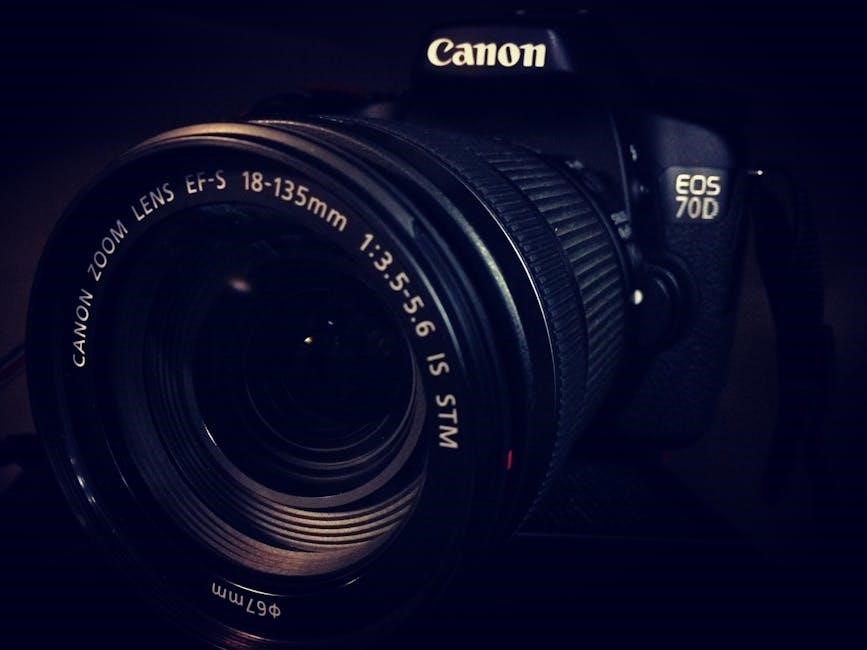The Canon EOS Digital Rebel XT/350D manual is a comprehensive guide to understanding and mastering the camera’s features, ensuring optimal photography experiences for both beginners and professionals.
1.1 Overview of the Canon EOS Digital Rebel XT/350D
The Canon EOS Digital Rebel XT/350D is a high-quality DSLR camera designed for both amateur and professional photographers. Known for its 8.0-megapixel CMOS sensor, it delivers crisp and detailed images. The camera features a compact design, intuitive controls, and compatibility with EF-S lenses. It supports RAW and JPEG file formats, offering flexibility in post-processing. With advanced shooting modes and customizable settings, the XT/350D is a versatile tool for capturing stunning photographs. Its user-friendly interface makes it accessible to newcomers while providing advanced features for seasoned photographers.
1.2 Importance of the Manual for Camera Operation
The Canon EOS Digital Rebel XT/350D manual is essential for understanding the camera’s features, settings, and modes. It provides detailed instructions on how to unlock the full potential of the camera, ensuring optimal performance. Whether you’re a beginner or an advanced photographer, the manual serves as a guide to mastering techniques, troubleshooting issues, and customizing settings. It also covers maintenance tips and compatibility with accessories, making it a vital resource for maximizing the camera’s capabilities and achieving professional-grade results in various photography scenarios.

Key Features of the Canon EOS Digital Rebel XT/350D
The Canon EOS Digital Rebel XT/350D features an 8.0-megapixel APS-C sensor, compact design, 2.4-inch LCD screen, and compatibility with EF-S lenses, ensuring excellent image quality and portability.
2.1 Camera Specifications and Technical Details
The Canon EOS Digital Rebel XT/350D features an 8.0-megapixel APS-C CMOS sensor, DIGIC II image processor, and a 2.4-inch LCD screen with 230,000 dots. It supports EF-S lens compatibility, offering a 7-point autofocus system for precise focusing. The camera operates with a shutter speed range of 1/4000 to 30 seconds, plus bulb mode, and offers an ISO range of 100-1600, expandable to 3200. Continuous shooting is available at 3fps, and it uses CF memory cards. The battery is the NB-2LH type, and the body weighs approximately 540g without the lens.
2.2 Unique Features Compared to Other Canon EOS Models
The Canon EOS Digital Rebel XT/350D stands out with its compact lightweight design, offering an 8.0-megapixel sensor and DIGIC II processor for enhanced image quality. It supports EF-S lenses, providing compatibility with a wide range of optics. The camera features a built-in flash and supports external flash units, offering versatile lighting options. Additionally, it includes a 2.4-inch LCD for image preview and review, making it user-friendly. Its ability to shoot in RAW format and compatibility with EOS Utility for remote shooting further distinguish it from other models in the Canon EOS lineup.

Downloading and Understanding the Canon EOS Digital Rebel XT/350D Manual
The Canon EOS Digital Rebel XT/350D manual is available for download on Canon’s official website in PDF format, providing detailed instructions for camera operation and troubleshooting.
3.1 Where to Find the Official Canon EOS Digital Rebel XT/350D Manual
The official Canon EOS Digital Rebel XT/350D manual can be found on Canon’s website. Visit the support section, select your camera model, and download the PDF manual. The file, named EOS DIGITAL Rebel XT / 350D Instruction Manual, is available for free. Ensure you have Adobe Acrobat installed to view it. The manual is also included in the product package. For troubleshooting, Canon offers additional resources and FAQs on their support page.
3.2 How to Download and Save the Manual in PDF Format
To download the Canon EOS Digital Rebel XT/350D manual, visit the Canon support website. Select your camera model from the list, then click on the EOS DIGITAL Rebel XT / 350D Instruction Manual link. Choose “Save” when prompted, and select a folder for storage. The file is approximately 4.24 MB in size. Ensure you have a PDF reader installed to view it. Save the manual in a dedicated folder for easy access and future reference, such as “Canon Manuals” or “Camera Guides.”
3.3 Navigating the Manual: Structure and Content
The Canon EOS Digital Rebel XT/350D manual is organized into sections for easy navigation. It begins with an overview of camera features, followed by detailed instructions on shooting modes, custom settings, and maintenance. The manual includes troubleshooting guides, FAQs, and advanced tips for professionals. Use the table of contents or bookmarks to quickly locate specific topics. The comprehensive index at the end helps users find information efficiently. Each section is designed to guide users from basic to advanced camera operations, ensuring a smooth learning experience. Regular updates may be available online for the latest features and improvements.

Compatible Accessories and Equipment for the Canon EOS Digital Rebel XT/350D
Discover compatible lenses, memory cards, batteries, and tripods for the Canon EOS Digital Rebel XT/350D. Explore official Canon recommendations to enhance functionality and ensure optimal performance.
4.1 Recommended Lenses and Lens Compatibility
For the Canon EOS Digital Rebel XT/350D, the EF-S 18-55mm f/3.5-5.6 II kit lens is ideal for everyday photography. Compatible with EF and EF-S lenses, the camera supports a variety of focal lengths for diverse shooting needs. Explore wide-angle, telephoto, and macro lenses to expand your creative possibilities. Canon ensures seamless integration with its range of optics, enhancing image quality and versatility for both casual and professional use.
4.2 Memory Cards and Storage Solutions
The Canon EOS Digital Rebel XT/350D supports CompactFlash (CF) cards for storage. Recommended cards include high-speed CF cards from brands like SanDisk or Lexar. The camera is compatible with CF cards up to 8GB, ensuring ample storage for RAW and JPEG files. For optimal performance, use cards with a minimum write speed of 15MB/s. Always format memory cards in the camera to prevent data loss and ensure compatibility. This ensures smooth operation and reliable image storage during photography sessions.
4.3 Battery and Charger Information
The Canon EOS Digital Rebel XT/350D uses the Battery Pack NB-2LH, which provides reliable power for extended shooting sessions; The camera also includes a lithium backup battery for maintaining date and time settings. Use the Battery Charger CB-2LT or CB-2LTE to recharge the NB-2LH. Ensure the battery is fully charged before extended use. Avoid using exhausted batteries to prevent data loss. Always store spare batteries in a cool, dry place to maintain their performance and longevity.
4.4 Tripods and Remote Shutter Releases
Using a tripod with the Canon EOS Digital Rebel XT/350D ensures stability, reducing camera shake and blur. Remote shutter releases, like the RC-1 or RC-5, allow hands-free shooting, minimizing vibration. To use a remote, set the Drive Mode to TIMER/REMOTE via the camera’s menu. Connect the remote shutter cable to the camera’s socket and trigger shots remotely. This setup is ideal for long exposures, macro photography, or group portraits. For added convenience, the camera’s timer function can also be activated for delayed shooting.

Shooting Modes and Settings on the Canon EOS Digital Rebel XT/350D
The Canon EOS Digital Rebel XT/350D offers various shooting modes, allowing customization for different scenarios, ensuring optimal results in diverse lighting conditions and creative needs.
5.1 Auto Mode vs. Manual Mode: When to Use Each
The Canon EOS Digital Rebel XT/350D offers Auto Mode for quick, hassle-free shooting, ideal for beginners or casual photography. Manual Mode provides full control over aperture, shutter speed, and ISO, perfect for creative photography and precise results. Use Auto Mode for everyday snapshots and Manual Mode for professional photography, creative control, or challenging lighting conditions, ensuring optimal results tailored to your vision.
5.2 Understanding Aperture, Shutter Speed, and ISO Settings
Aperture, shutter speed, and ISO are fundamental for controlling exposure and image quality. Aperture regulates light entry and depth of field, with lower f-stops opening the lens wider. Shutter speed determines motion blur, with faster speeds freezing action. ISO adjusts sensitivity to light, lower values suited for bright conditions and higher for low light. Balancing these settings on the Canon EOS Digital Rebel XT/350D ensures precise control over lighting, enabling photographers to achieve desired effects in various scenarios, from portraits to dynamic action shots.
5.3 Scene Modes for Different Photography Needs
The Canon EOS Digital Rebel XT/350D offers various scene modes tailored for specific photography scenarios. Portrait mode softens backgrounds to emphasize subjects, while Landscape mode ensures sharp focus across vast scenes. Close-up mode captures fine details, and Sports mode freezes fast-moving subjects. Night Portrait mode balances subject and background lighting in low-light conditions. These modes simplify photography by automatically adjusting settings, allowing users to focus on composition and creativity, making the camera versatile for diverse shooting situations and skill levels.
Customizing Your Canon EOS Digital Rebel XT/350D
Customizing your Canon EOS Digital Rebel XT/350D involves personalizing settings and updating firmware for enhanced performance and tailored photography experiences easily.
6.1 Personalizing Camera Settings for Optimal Use
Personalizing your Canon EOS Digital Rebel XT/350D involves tailoring camera settings to suit your photography style. Custom Functions allow you to adjust autofocus, metering, and bracketing. Assign frequently used functions to buttons for quick access. Configure the AF system to prioritize speed or accuracy based on your subject. Set up custom white balance presets for consistent color reproduction. Save personalized settings to streamline your workflow. Regularly review and update your configurations to adapt to new techniques or shooting environments for enhanced creativity and efficiency.
6.2 Updating Firmware for Enhanced Performance
Updating the firmware of your Canon EOS Digital Rebel XT/350D ensures optimal performance and access to new features. Check the current firmware version via the camera menu and compare it to the latest version available on Canon’s official website; Download the update to a memory card using a card reader or directly through the camera. Follow the on-screen instructions carefully to install the update, ensuring the battery is fully charged and the camera is not interrupted during the process. This enhances functionality, improves compatibility, and resolves potential issues for a smoother photography experience.

Image Quality and File Formats on the Canon EOS Digital Rebel XT/350D
The Canon EOS Digital Rebel XT/350D supports RAW and JPEG formats, offering flexibility in image quality. RAW captures detailed data for post-processing, while JPEG provides compressed, ready-to-use files.
7.1 RAW vs. JPEG: Choosing the Right File Format
The Canon EOS Digital Rebel XT/350D allows shooting in RAW (.CR2) or JPEG formats. RAW files retain maximum image detail for advanced editing, while JPEG files are compressed and ready for sharing. Choose RAW for professional editing or JPEG for convenience. RAW is ideal for capturing high dynamic range and precise color accuracy, but requires post-processing. JPEG is suitable for everyday use, offering smaller file sizes and immediate usability. Select based on your workflow and photography goals.
7.2 Adjusting Image Quality Settings for Different Shoots
Adjusting image quality settings on the Canon EOS Digital Rebel XT/350D allows customization for specific photography needs. For landscapes, use high-resolution settings to capture detailed scenes. Portraits benefit from lower compression to preserve skin tones. Action shots may require faster write times with JPEG. Experiment with color depth and sharpness to enhance results. Fine-tune settings based on lighting conditions and subject complexity for optimal image output. Proper adjustments ensure your photos meet artistic and technical goals, whether for professional or personal use.

Maintenance and Cleaning of the Canon EOS Digital Rebel XT/350D
Regular maintenance and cleaning are crucial for protecting the camera and lens, ensuring optimal performance and longevity. Follow proper techniques to maintain functionality and image quality.
8.1 Cleaning the Camera Sensor and Lens
Cleaning the sensor and lens is essential for maintaining image quality. Turn off the camera, detach the lens, and use a soft brush or blower to remove dust. For stubborn spots, gently wipe the lens with a microfiber cloth and cleaning solution. Avoid harsh chemicals or excessive moisture. Use a dry, anti-static cloth for the sensor, following the manual’s instructions. Regular cleaning prevents smudges and ensures sharp, clear photos. If unsure, consult a professional to avoid damage.
8.2 Regular Maintenance Tips for Longevity
Regular maintenance ensures your Canon EOS Digital Rebel XT/350D performs optimally. Store the camera in a cool, dry place to prevent moisture damage. Clean the sensor and lens regularly to avoid dust buildup. Charge batteries properly and avoid extreme temperatures. Update firmware periodically for improved functionality. Use only Canon-approved accessories to maintain compatibility and performance. Refer to the manual for detailed maintenance routines to extend your camera’s lifespan and ensure consistent image quality over time.

Troubleshooting Common Issues with the Canon EOS Digital Rebel XT/350D
Identify common issues like error messages and communication problems. Restart the camera and check connections. Ensure proper settings for remote and lens compatibility to resolve malfunctions quickly.
9.1 Resolving Error Messages and Camera Malfunctions
When encountering error messages, restart the camera and ensure all connections are secure. Check the communication mode settings, especially for remote control or lens compatibility. For issues like Print/PTP mode errors, switch to a supported mode. Clean the sensor and lens regularly to prevent malfunctions. If problems persist, refer to the manual or Canon support for detailed troubleshooting guides and firmware updates to restore optimal functionality.
9.2 Common Problems and Their Solutions
Common issues with the Canon EOS Digital Rebel XT/350D include error messages related to communication modes, lens incompatibility, and sensor cleaning. For Print/PTP mode errors, switch to a compatible mode. Remote control malfunctions may require checking the shutter release cable connection. RAW image compatibility issues can be resolved by using supported software. Regular firmware updates and proper camera maintenance help prevent these problems. Refer to the manual or Canon support for detailed troubleshooting and solutions.
Canon EOS Digital Rebel XT/350D Software and Utilities
The Canon EOS Digital Rebel XT/350D supports EOS Utility for remote shooting and image transfer, along with compatible software like CameraWindow for efficient image editing and management.
10.1 EOS Utility for Remote Shooting and Image Transfer
EOS Utility allows users to control the Canon EOS Digital Rebel XT/350D remotely via USB, enabling live view, focusing, and shutter release. It also facilitates image transfer to a computer. The software is compatible with both Windows and Mac operating systems. Detailed instructions for installation and usage are provided in the official manual. This tool enhances workflow efficiency for photographers, offering precise control over camera settings and image management. It is an essential utility for professionals and enthusiasts alike, ensuring seamless connectivity and operation. Always refer to the manual for setup guidance.
10;2 Compatible Software for Image Editing and Management
The Canon EOS Digital Rebel XT/350D supports various software for image editing and management. Adobe Photoshop and Lightroom are popular choices for editing RAW and JPEG files. Canon’s EOS Utility and Digital Photo Professional are also recommended for organizing and enhancing images. These tools allow users to adjust settings like white balance and noise reduction. Additionally, the camera supports file formats such as CR2, CRW, and TIFF, ensuring compatibility with most photo editing programs. Always refer to the manual for detailed software setup guidance.

Remote Control Usage with the Canon EOS Digital Rebel XT/350D
Set the Drive Mode to Timer/Remote, connect the remote shutter cable, and trigger the shutter for hands-free photography, ensuring precise control over your shots.
11.1 Setting Up the Remote Shutter Release
To set up the remote shutter release for the Canon EOS Digital Rebel XT/350D, begin by enabling the Timer/Remote mode via the Drive Mode Selection Button. Next, insert the 2.5mm stereo jack of the remote shutter cable into the camera’s remote shutter socket. Once connected, you can activate the remote shutter release to capture images without physical contact with the camera, minimizing vibrations and ensuring sharp photos. This setup is ideal for tripod-based shooting or self-portraits, offering precise control over your photography sessions.
11.2 Using the Timer Function for Hands-Free Shooting
The Canon EOS Digital Rebel XT/350D’s timer function allows hands-free shooting, reducing camera shake and blur. To activate, set the Drive Mode to Timer/Remote. Choose a delay (2 or 10 seconds) via the menu. Press the shutter button to start the countdown. The camera will automatically capture the image after the selected delay, enabling sharp photos without physical contact. This feature is ideal for tripod-based photography, group shots, or self-portraits, ensuring precise control and minimizing vibrations for clearer results.

FAQs About the Canon EOS Digital Rebel XT/350D Manual
Commonly asked questions include where to download the manual, basic camera operations, and troubleshooting tips. It also covers firmware updates and compatibility with accessories.
12.1 Common Questions from New Users
New users often ask about basic camera operations, such as setting up the remote control, using CF memory cards, and understanding file formats like RAW and JPEG. They also inquire about essential accessories, like the EF-S18-55mm lens, and how to navigate the manual for troubleshooting common issues. Additionally, questions about updating firmware, connecting to computers, and using scene modes frequently arise. The manual addresses these topics in detail, ensuring users can easily find solutions and improve their photography skills.
12.2 Advanced Tips for Professional Photographers
Professional photographers can enhance their workflow by utilizing RAW format for maximum image control and leveraging the timer or remote shutter release for shake-free shots. Customizing settings for quick access and regularly updating firmware ensures optimal performance. Advanced users also benefit from exploring compatible lenses like the EF-S18-55mm for versatility and using tools like EOS Utility for remote shooting and image transfer, streamlining their photography process.
The Canon EOS Digital Rebel XT/350D manual provides essential guidance for unlocking the camera’s full potential, ensuring photographers master its features and achieve exceptional results in every shoot.
13.1 Summary of Key Points
The Canon EOS Digital Rebel XT/350D manual offers detailed insights into camera operation, features, and customization. It covers shooting modes, image quality settings, and maintenance tips. The guide also provides troubleshooting solutions and explains how to use compatible software and accessories. By following the manual, photographers can enhance their skills and maximize the camera’s capabilities, ensuring high-quality results in various photography scenarios. Referencing the manual regularly helps users stay updated and proficient with their device.
13.2 Final Tips for Mastering the Canon EOS Digital Rebel XT/350D
Regularly update firmware for enhanced performance and new features. Experiment with shooting modes and settings to find what works best for your style. Refer to the manual for troubleshooting and customization options. Organize your images efficiently using compatible software. Practice cleaning and maintaining the camera to ensure longevity. For remote shooting, use the timer function or remote shutter release for hands-free photography. By following these tips, you can unlock the full potential of your Canon EOS Digital Rebel XT/350D and capture stunning photos consistently.

Be First to Comment